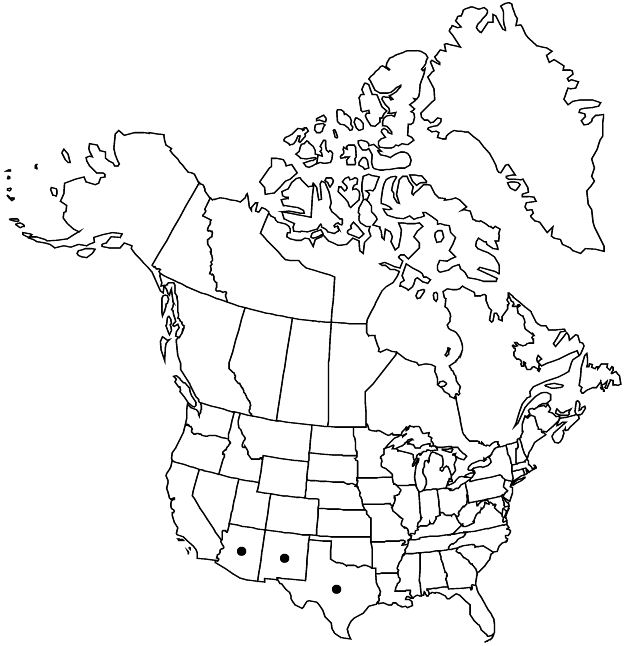Difference between revisions of "Cercocarpus breviflorus"
Smithsonian Contr. Knowl. 5(6): 54. 1853.
FNA>Volume Importer |
imported>Volume Importer |
||
| (2 intermediate revisions by 2 users not shown) | |||
| Line 65: | Line 65: | ||
|publication year=1853 | |publication year=1853 | ||
|special status= | |special status= | ||
| − | |source xml=https:// | + | |source xml=https://bitbucket.org/aafc-mbb/fna-data-curation/src/2e0870ddd59836b60bcf96646a41e87ea5a5943a/coarse_grained_fna_xml/V9/V9_550.xml |
|subfamily=Rosaceae subfam. Dryadoideae | |subfamily=Rosaceae subfam. Dryadoideae | ||
|tribe=Rosaceae tribe Dryadeae | |tribe=Rosaceae tribe Dryadeae | ||
Latest revision as of 22:57, 5 November 2020
Shrubs, (5–)10–30(–60) dm, sparsely to moderately branched. Stems: long-shoot internodes (3–)7–20(–37) mm, sericeous, pilose-hirsute or villous, glabrate; short shoots 5–60(–140) × 1.5–2.5 mm. Leaves persistent or drought-deciduous; stipules 1.5–2.5(–3) mm; petiole (1–)2–5(-9) mm; blade narrowly oblanceolate, oblong-oblanceolate, oblong-elliptic, narrowly obovate to obovate, sometimes ovate, (3–)7–35(–52) × (1.3–)4–15(–28) mm, coriaceous to subcoriaceous, base narrowly to broadly cuneate, margins serrulate to crenate in distal 1/2–1/3, teeth acute-apiculate, antrorse or proximal divergent in large leaves, or smaller blades entire, apex rounded to apiculate, abaxial surface sericeous, villous, or hirsute on veins, areoles canescent, rarely glabrous, adaxial moderately sericeous, hirsute, or villous. Flowers 1–3(–7) per short shoot; hypanthial tubes sericeous, hirsute-pilose to villous; hypanthial cups 1.5–2.5 × 2.5–4 mm; sepals 5, narrowly deltate, 1–2 mm, acute; stamens (15–)20–40, anthers 0.6–1.2 mm, hirsute. Achenes 6–9(–10.7) × 1.3–2 mm; fruiting pedicels (1–)2–5(–11.3) mm; hypanthial tubes (4–)6–9(–10.2) mm; pedicel/tube ratio (18–)30–50(–135)%; fruit awns (2.5–)3.5–5(–7.2) cm, proximal setae 1.5–2.7 mm.
Phenology: Flowering late Jun–Aug(–Sep).
Habitat: Yellow pine, fir forests, pinyon, juniper, oak woodlands, chaparral, grasslands, desert mountains, rocky, limestone, sandstone or rhyolite substrates
Elevation: 1500–2600 m
Distribution

Ariz., N.Mex., Tex., Mexico (Chihuahua, Coahuila, Durango, Hidalgo, Nuevo León, Querétaro, San Luis Potosí, Sonora, Tamaulipas, Zacatecas).
Discussion
Cercocarpus breviflorus grows in the mountains of north-central Arizona, south-central New Mexico, and central and trans-Pecos Texas and in Mexico, over a 2000 km range. It has smaller flowers and shorter fruiting pedicels, hypanthial tubes, and stipules than C. betuloides. Flowering occurs after summer rains, providing reproductive isolation from C. betuloides.
In the mountains from east-central Arizona into north-central New Mexico, about 70–80% of plants of Cercocarpus breviflorus have pilose-hirsute to villous vestiture, and leaves tend to be thinner and more obovate with five to seven teeth in the rounded apical margins. In more arid montane regions of southern New Mexico, trans-Pecos Texas, and Mexico, leaves are more commonly sericeous (70%), often smaller, more coriaceous, with fewer teeth, in extreme being entire with a single terminal tooth. In strongly arid conditions, plants are smaller, more intricately branched, and thorny. These differences appear suitable for taxonomic recognition; a broad zone of intergradation occurs in southeastern Arizona and south-central New Mexico.
In the Big Bend region and Hill County of Texas and in the Chihuahuan Desert and mountains of eastern Mexico, plants of Cercocarpus breviflorus in more mesic chaparral habitats on north-facing slopes and drainages are taller with larger, sericeous, toothed leaves, often with the proximal teeth divergent. These plants blend completely into smaller-leaved plants in more arid sites on the same mountains. As in the C. betuloides complex, there are also plants with glabrous abaxial areoles.
Selected References
None.